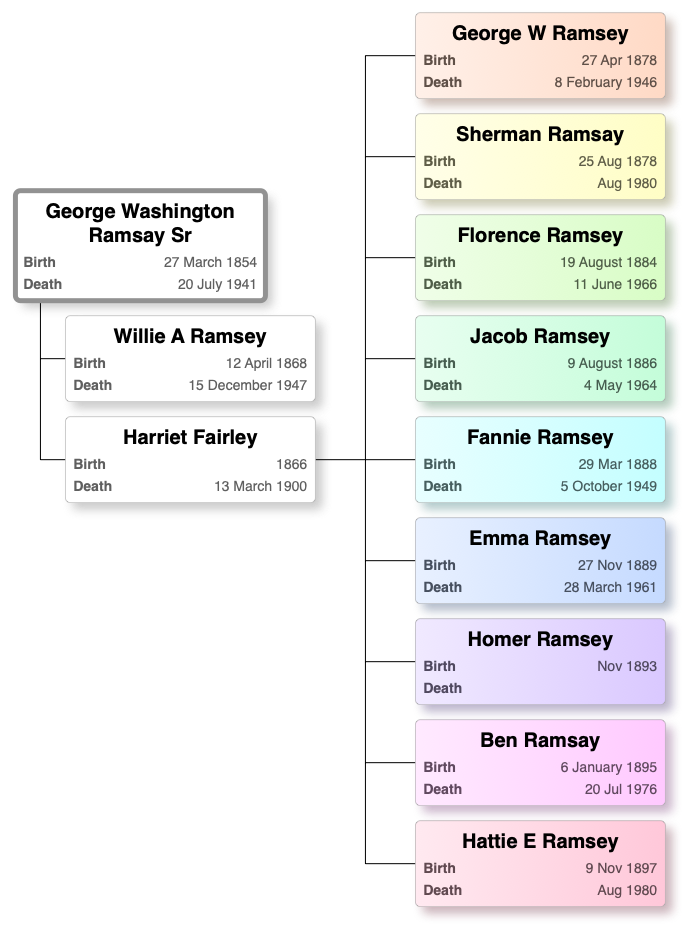George Ramsay Sr.
Also Known By:
- George Washington Ramsay Sr.
1854 - 1941
As with Greene, George’s first and middle name, “George Washington,” deserves notice. It is an indication of the high thoughts enslaved blacks had at time of these two presidents, Thomas Jefferson and George Washington. George was of medium height, light-skinned man with long silver hair. George married twice. His first wife was named Harriet. Marriage records indicate that Harriet’s maiden name was Fairley and that she may have been fourteen years old when she married George. It should be noted that there is little known about Harriet, as she died in her early 30’s, during the late 1800s. George Sr. and Harriet had six boys and three girls, Florence (nicknamed Loss), Ben, Sherman, George Jr. (nicknamed Tobe), Jacob, Homer, Fannie, Emma, and Hattie.
After Harriet died, George later married a lady they called Mrs. Willie, who was from Alabama. George and Mrs. Willie did not have children together. However, she did have a son prior to their marriage. It is known that in their later years, George and Willie were both blind.
Interviews with two of George’s granddaughters, Gloria Johnson-Husband and Olivia Ramsey-McClendon, indicate that even though they were blind they were still able to continue living a somewhat normal life. Ms. Willie could still make up the bed without leaving any wrinkles, and they both could go to the outhouse to use the restroom without any assistance.
Before going blind, George was well known for riding around on his big white horse. He would ride his horse from Ramsey Springs up to areas in and around Wiggins. His granddaughter, Emma Grace Whitlock recalls him riding his horse in the morning with a whip in hand to make sure that his children and grandchildren would get to the school on time. There was no indication that he ever used the whip.
Stories also indicate that George loved to entertain, but his guests were not just those of his race, he had many white visitors. Some family members say that he had a guestroom where his visitors, whether they were white or black, could spend the night. Some of his grandchildren remember playing in his hair while he rested in his rocking chair. It should be noted that his favorite rocking chair was hand-carved by his father, Bat. One of his nephews, Edward Davis, remembers George, who at the time was old and blind, would sit on the porch in his rocking chair and tell stories. While telling his stories, he would twist and chew tobacco leaves. The children knew that when they heard that hacking sound coming from his mouth, it was time for them to get up and run. George would spit out the tobacco juice without knowing where he was spitting. The children would flee to avoid being spattered with tobacco juice.
“Gulf Coast Country” mentions that George lived on the same land where he was a slave and was now ruler of it. And if there was ever any trouble, George would call a family meeting by ringing a cow bell. He did most of the talking and the rest of the family listened. His farm was self-sustaining, and he, his children and grandchildren were the laborers. Of course, all had to work on the farm and every girl had to also know how to cook, sew, tend to the flowers and make quilts. He grew corn and sweet potatoes, vegetables for both his family and the market. He made molasses, his own corn meal, and sugar from the sugar cane. He also had plenty of livestock. The WPA conducted an extensive interview with him when he was 69 years of age. The interview is very enlightening about slavery, Booker T. Washington, and his views in general of the young folks at the time.

